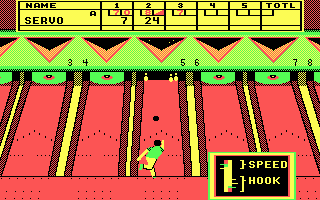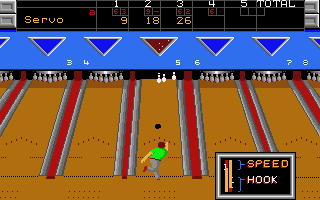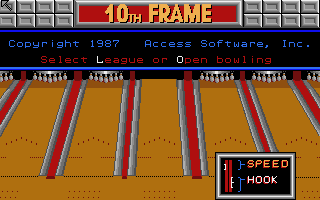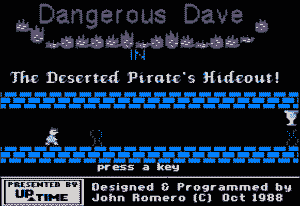Retro Replay Review
Gameplay
10th Frame delivers a straightforward yet surprisingly engaging bowling simulation that harkens back to the early days of sports video games. Drawing inspiration from the mechanics introduced in Leader Board, Bruce and Roger Carver have crafted a simple three-click system: one click to set the initial angle, another to register the ball’s speed, and a final click to apply hook or curve. This sequence demands timing and precision, transforming what might seem like a casual pastime into a test of reflexes and patience.
(HEY YOU!! We hope you enjoy! We try not to run ads. So basically, this is a very expensive hobby running this site. Please consider joining us for updates, forums, and more. Network w/ us to make some cash or friends while retro gaming, and you can win some free retro games for posting. Okay, carry on 👍)
The inclusion of three distinct skill levels—Kids, Amateur, and Professional—ensures that players of varying expertise can find a comfortable entry point. In Kids mode, speed and hook are handled automatically, allowing newcomers to focus solely on timing. The Amateur setting introduces more latitude for fine-tuning hook and slice control, granting a forgiving margin of error that eases the transition to the most challenging Professional level, where every click truly matters.
Matches can be played either as stand-alone games or within a league structure, giving bowlers the option to compete in quick one-offs or embark on a longer-term campaign. The lane selection screen displays a plan view of five lanes, with the four adjacent lanes left unoccupied—an aesthetic touch that underscores the solitary focus on your own performance. Whether you prefer a casual frame or chasing a high-series total, 10th Frame’s gameplay loop remains surprisingly addictive.
Graphics
By modern standards, 10th Frame’s visuals are stark and utilitarian, yet they effectively convey all the necessary information. The overhead, plan-view perspective simplifies the action, presenting players with a clear, unobstructed look at the lane and pin setup. While there are no flashy animations or dynamic camera angles, the minimalistic presentation ensures that the core mechanic—the click-timing system—remains front and center.
Bowling pins are represented by simple sprites, and the ball’s motion is tracked via a smooth, if modest, animation sequence that updates progressively down the lane. Lane markings and gutters are rendered in contrasting colors, making it easy to judge the ball’s alignment and anticipated path. The UI elements that display current frame, score, and player turn are cleanly laid out along the top of the screen, reinforcing clarity over spectacle.
Environmental details are sparse—there are no cheering crowds or animated lane attendants—but this lack of extras helps maintain focus on the gameplay itself. Sound effects consist of a modest roll of the bowling ball and the satisfying clatter of pins—simple but effective. In the context of early bowling videogames, 10th Frame’s graphics may lack bells and whistles, but they serve their purpose admirably and never get in the way of setting up the perfect strike.
Story
True to its roots as a sports simulation, 10th Frame offers little in the way of narrative or character development. There is no overarching storyline or cast of quirky personalities to guide your journey down the lanes. Instead, the game’s “story” emerges organically through the progression of frames, the thrills of consecutive strikes, and the occasional gut-wrenching gutter ball that keeps the stakes surprisingly high.
The league mode injects a sense of continuity by tracking standings, cumulative scores, and match outcomes, providing a rudimentary progression system that simulates the ebb and flow of a real bowling season. While there are no rival teams with distinctive logos or scripted cutscenes, the simple leaderboard mechanics and sense of rival competition can still foster rivalry among friends gathering around the same machine.
For players seeking a rich narrative or character-driven campaign, 10th Frame may feel sparse. Yet by keeping the focus squarely on the sport itself, Bruce and Roger Carver have ensured that your personal highs and lows become the game’s defining storyline. Whether you’re celebrating a perfect game or lamenting a 10th-frame gutter ball, the emotional resonance of each roll carries its own narrative weight.
Overall Experience
As one of the earliest tenpin bowling videogames, 10th Frame strikes a solid balance between approachability and depth. Its timing-based input system may sound simplistic, but it offers layers of mastery: perfecting the angle click, dialing in the right speed, and adding just enough hook to carve through the pins. The three difficulty tiers cater to novices and seasoned players alike, making it an accessible title for family gatherings or solo practice sessions.
While the graphics and audio are undeniably retro, they never detract from the core enjoyment of rolling strike after strike. In fact, the clean, uncluttered presentation helps keep players focused on the rhythm of the game rather than flashy distractions. The option to play single matches or engage in a league format adds a welcome element of replayability, encouraging bowlers to chase incremental improvements and new personal bests.
Ultimately, 10th Frame delivers a tightly designed sports simulation that stands the test of time. Its reliance on timing, precision, and strategic hook control offers a satisfying gameplay loop that remains engaging even after dozens of games. For enthusiasts of retro sports titles or anyone looking for a straightforward, pick-up-and-play bowling experience, 10th Frame remains a noteworthy classic worth adding to your collection.
 Retro Replay Retro Replay gaming reviews, news, emulation, geek stuff and more!
Retro Replay Retro Replay gaming reviews, news, emulation, geek stuff and more!









Reviews
There are no reviews yet.